
In naval terminology, a destroyer is a fast, maneuverable, long-endurance warship intended to escort larger vessels in a fleet, convoy, or carrier battle group and defend them against a wide range of general threats. They were originally conceived in 1885 by Fernando Villaamil for the Spanish Navy as a defense against torpedo boats, and by the time of the Russo-Japanese War in 1904, these "torpedo boat destroyers" (TBDs) were "large, swift, and powerfully armed torpedo boats designed to destroy other torpedo boats". Although the term "destroyer" had been used interchangeably with "TBD" and "torpedo boat destroyer" by navies since 1892, the term "torpedo boat destroyer" had been generally shortened to simply "destroyer" by nearly all navies by the First World War.

The Bulgarian Navy is the navy of the Republic of Bulgaria and forms part of the Bulgarian Armed Forces.
Storozhevoy was the lead ship of her class of 18 destroyers built for the Soviet Navy during the late 1930s. Although she began construction as a Project 7 Gnevny-class destroyer, Storozhevoy was completed in 1940 to the modified Project 7U design.

Imperatritsa Ekaterina Velikaya was the second of three Imperatritsa Mariya-class dreadnoughts built for the Imperial Russian Navy during World War I. Completed in 1915, she was assigned to the Black Sea Fleet. She engaged the ex-German battlecruiser Yavûz Sultân Selîm once, but only inflicted splinter damage while taking no damage herself. The ship briefly encountered an Ottoman light cruiser, but mostly covered the actions of smaller ships during the war without firing her guns. These included minelaying operations off the Bosporus and anti-shipping sweeps of the coast of Anatolia. Imperatritsa Ekaterina Velikaya was renamed Svobodnaya Rossiya after the February Revolution of 1917.
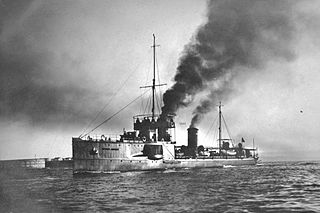
Leytenant Zatsarenny was an Imperial Russian Navy destroyer of the four-strong Leytenant Shestakov class.

A torpedo cruiser is a type of warship that is armed primarily with torpedoes. The major navies began building torpedo cruisers shortly after the invention of the locomotive Whitehead torpedo in the 1860s. The development of the torpedo gave rise to the Jeune École doctrine, which held that small warships armed with torpedoes could effectively and cheaply defeat much larger battleships. Torpedo cruisers fell out of favor in most of the great power navies in the 1890s, though many other navies continued to acquire them into the early 1900s.
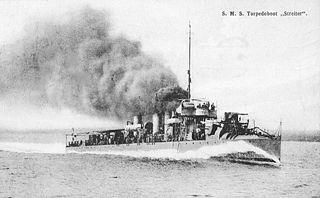
The Huszár class was a class of destroyers built for the Austro-Hungarian Navy before the First World War. They were built to a design by the British shipbuilder Yarrow Shipbuilders, who built the first ship, with a further 11 ships being built in Austrian and Hungarian yards between 1905 and 1909. A replacement ship was built when the lead ship was lost in an accident in 1908, and another ship of similar design building for the Chinese navy was seized on the outbreak of the First World War. Two ships were lost during the war, a single ship serving with the Greek Navy following the end of the war, and the remainder being scrapped.

The B 97 class was a class of eight destroyers built for and operated by the Imperial German Navy during the First World War. They served throughout the war, with one being lost in 1915, five being scuttled at Scapa Flow in 1919 and one being transferred to Italy, where it remained in use until 1939.
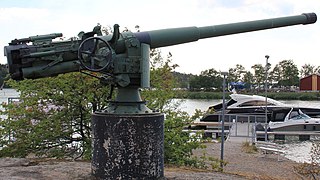
The 102 mm 60 caliber Pattern 1911 was a Russian naval gun developed in the years before World War I that armed a variety of warships of the Imperial Russian Navy during World War I. Pattern 1911 guns found a second life on river gunboats and armored trains during the Russian Civil War and as coastal artillery during World War II. In 1941 it was estimated that 146 guns were in service. Of these, 49 were in the Baltic Fleet, 30 in the Black Sea Fleet, 30 in the Pacific Fleet, 18 in the Northern Fleet, 9 in the Caspian Flotilla and 6 in the Pinsk Flotilla.
The M89 class were a planned series of destroyers for the French Navy. Although initially designed in 1913, the scheduled construction of the two new destroyers was suspended due to the outbreak of World War I before either ship could be laid down. The two destroyers had not yet been given names, being known only by their planned construction numbers, M89 and M90.

Moskva was one of six Leningrad-class destroyer leaders built for the Soviet Navy during the 1930s, one of the three Project 1 variants. Completed in 1938 and assigned to the Black Sea Fleet, she participated in the Raid on Constanța on 26 June 1941, a few days after the beginning of the German invasion of the Soviet Union. After the ship had finished bombarding targets in the port, she was sunk by a mine.

Kharkov was a Leningrad-class destroyer leader built for the Soviet Navy during the 1930s, one of the three Project 1 variants. Completed in 1938, she was slightly damaged during the Raid on Constanța a few days after the German invasion of the Soviet Union on 22 June and covered the evacuation of the Danube Flotilla to Odessa the following month. During the Siege of Odessa and the Siege of Sevastopol in 1941–1942, the ship ferried reinforcements and supplies into those cities, evacuated wounded and refugees and bombarded Axis troop positions. Damaged by German aircraft a few weeks before the surrender of Sevastopol on 4 July, Kharkov was under repair until the beginning of August.
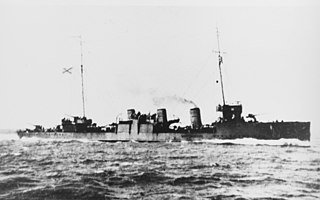
Gadzhibey (Гаджибей) was one of eight Fidonisy-class destroyers built for the Imperial Russian Navy during World War I. Completed in late 1917, too late to see active service during the war, Gadzhibey's sailors joined the Bolsheviks after the October Revolution. In early 1918, the destroyer assisted in the consolidation of Soviet control over Crimea, fighting against Crimean Tatar forces at Yalta and Alushta. After the German-Ukrainian invasion of Crimea, she was withdrawn to Novorossiysk and scuttled there in June to avoid capture by German forces. Raised by the Soviet Union in the late 1920s, Gadzhibey was deemed uneconomical to repair and scrapped. Her propulsion machinery was used to refit a sister ship.

Razyaryonny was one of 29 Gnevny-class destroyers built for the Soviet Navy during the late 1930s. Originally named Peredovoy, she was renamed Razyaryonny before completion in late 1941, and was assigned to the Pacific Fleet.

Gavriil was an Orfey-class destroyer of the Russian Imperial Navy. The destroyer was built by the Russo-Baltic Yard at Reval, launching on 5 January 1915 and completing in October 1916. She served with the Baltic Fleet during the remainder of the First World War, and after the October Revolution joined the Bolshevik Red Fleet. She was active during the Russian Civil War, taking part in several engagements against British ships during the British campaign in the Baltic, and was sunk by a mine on 21 October 1919.
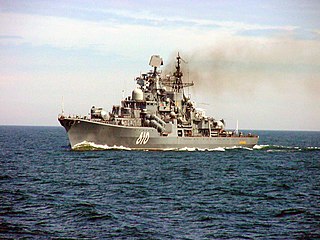
Nastoychivy is a Sovremenny-class destroyer of the Soviet and later Russian navy. Previously she was named Moskovsky Komsomolets before being renamed on 15 February 1992.
The German torpedo boat TA37 was an Ariete-class torpedo boat operated by the German Kriegsmarine during the Second World War. The ship was built for the Italian Navy by the shipbuilder CRDA at their Trieste shipyard with the name Gladio in 1943, but was incomplete when Italy surrendered to the Allies in September 1943, and was seized by Nazi Germany. The ship entered service as TA37 in 1944, serving in the Adriatic and Aegean seas and was sunk by British destroyers on 7 October 1944.

Leytenant Shestakov was a destroyer of the Imperial Russian Navy and the name ship of her class. The ship was built by the Naval Yard, Nikolayev from 1906 to 1909, being launched on 28 July 1908. The ship served in the Russian Black Sea Fleet during the First World War, passing to control of the Bolsheviks following the October Revolution but was scuttled on 18 June 1918 to avoid capture by German troops.

Kit was the second boat of the Narval class of submarines of the Imperial Russian Navy. The submarine was laid down in December 1911 and launched in May 1915, though it was not completed until October 1915. Built for the Black Sea Fleet, it carried out raids against Ottoman supply convoys along the coast of Anatolia and was responsible for sinking 24 ships, for a total of 1,270 gross register tons (GRT).


















